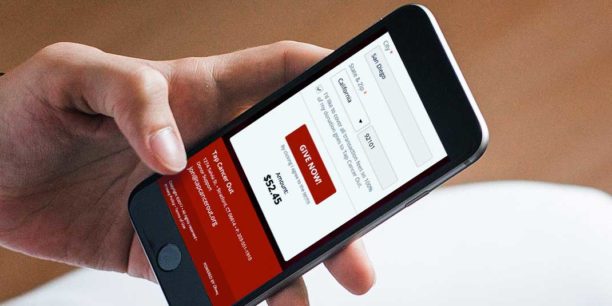Nonprofit Corporate Sponsorships: Real-Life Examples and Practical Advice

Amid financial uncertainty, inflation, and climate disasters, businesses and organizations are seeking ways to have a more meaningful impact on the world. For-profit and nonprofit corporate sponsorships offer heightened value when addressing these issues.
Whether facing funding challenges, preparing to scale your impact, or maintaining steady progress toward your mission, corporate sponsorships can be a great avenue and tool. When for-profit businesses offer resources to nonprofits, it helps strengthen corporate social responsibility models and boost public perception. It’s a win-win.
Below, we invite you to consider how your nonprofit can pitch and land a corporate sponsorship that takes your timely initiatives and impact to the next level. We outline six examples of nonprofit organizations and for-profits successfully establishing and managing robust sponsorship programs to engage new donor and customer demographics, amplify outreach potential, and reach new heights.
Corporate Sponsorship vs. Corporate Partnership
You’ll often see corporate sponsorship and corporate partnership used interchangeably, but these terms aren’t synonymous.
What Is a Corporate Sponsorship?
Corporate sponsorship refers to a company providing financial support, resources, or services to an event, organization, or cause in exchange for promotional benefits and exposure.
There are different types of corporate sponsorships, from matching campaigns and large financial gifts to marketing initiatives and employee giving programs.
Typically, corporate sponsors contribute funds or resources to help your nonprofit reach its goals. In return, the sponsor gains visibility, a brand image boost, and access to your target audience.
This usually happens through prominent sponsor logos on signage at events and special recognition. In addition, you’ll often see events with varying sponsorship levels that provide more sponsorship benefits to corporations that contribute larger amounts.
Sponsorship agreements are generally temporary and revolve around specific events, projects, or campaigns.
How Does It Differ from a Corporate Partnership?
Corporate partnerships involve a more collaborative and long-term relationship and often center on mutual interests, such as strategic goals, market expansion, product development, or technology sharing.
The corporate partners work together to leverage each other’s strengths and resources to create value and achieve specific outcomes. Unlike corporate sponsorships, partnerships tend to be more integrated and involve ongoing collaboration—sometimes extending years.
Finding the right corporate giving software is a great place to start.
How to Approach Corporate Sponsorships with Confidence
Soliciting corporate sponsorships can seem daunting, but it’s crucial to remember how impactful these can be on your reach and mission delivery. Here’s a comprehensive approach to an effective sponsorship request:
Identify Potential Partners
Look for businesses that align with your nonprofit’s causes and values. Focus on for-profit companies that share a similar audience or work with products related to your nonprofit.
Research Contacts
Research the person or department responsible for sponsorships after identifying potential partners. Use mutual contacts, if possible, to make the first introduction. Personal connections can significantly improve your chances of success.
Prepare Your Pitch
Develop a professional and engaging pitch that clearly explains how a partnership could benefit both parties. Highlight the potential for enhancing your reach and impact and any unique opportunities your nonprofit offers.
Customize Your Approach
Tailor your pitch to each prospective sponsor. Show that you understand their business and explain how partnering with your nonprofit can help them achieve their goals, whether it’s brand visibility, community engagement, or other objectives.
Follow Up
Follow up with the prospective sponsor after making your initial pitch. Be persistent but respectful, and be prepared to address any questions or concerns they may have.
Provide Value
Offer various sponsorship levels and benefits to appeal to different businesses. This could include logo placements, mentions in promotional materials, or opportunities for employee engagement.
Track Your Progress
Keep track of your outreach efforts and the responses you receive. This will help you refine your approach and identify what works best.
Be Flexible
Be open to negotiation and willing to adjust your pitch based on feedback. Building a successful sponsorship relationship often requires some flexibility and compromise.
6 Real-Life Examples of How to Leverage Corporate Sponsorships to Fuel Your Mission
1. Access Influencers and Major Donations through Heightened Visibility
Team Rubicon is a nonprofit that mobilizes veterans to respond to natural disasters and humanitarian crises. Feeling inspired by Team Rubicon’s work, Mountain Dew entered into a sponsorship agreement with them that generously offered a $1 million donation.
With its donation, Mountain Dew paired one of its celebrity influencers, professional race car driver Dale Earnhardt Jr., with the nonprofit’s cause. Mountain Dew framed Earnhardt Jr. as helping “rally DEW Nation to participate in the MTN DEW x Team Rubicon mission.”
“DEW Nation,” the company’s consumers, could then donate to Team Rubicon and receive limited-edition MTN DEW x Team Rubicon products, such as shirts, backpacks, tents, and an in-person race-day experience with Earnhardt Jr.
Partnering with a large corporation can bring resources to your nonprofit you may not otherwise get. So when collaborating with a for-profit, consider how it can elevate your cause, including influencers, products, marketing, and financial support.
2. Conduct Research and Raise Awareness
Team Rubicon also partnered with jerky company Jack Link’s Protein Snacks. This sponsorship focused heavily on research, education, and, of course, broad brand exposure.
Jack Link’s supported collecting national survey data on the long-term impacts of natural disasters to help Team Rubicon tell a data-driven story about its mission. These insights also helped educate Team Rubicon’s prospective donors on how Americans underestimate the impact of humanitarian crises and what its nonprofit team does to address that.
Framed by its decision to pursue the sponsorship with data-driven messaging, Jack Link’s further built a case that Team Rubicon’s value is evidence-based and donors’ money will go to good use.
The press release begins with:
“As hurricane season begins this month and devastating storms begin to take their annual toll on the country, new survey data from Jack Link’s Protein Snacks found that Americans misunderstand the long-term impact of these storms, and other natural disasters, on communities—many of which are still in need of relief and aid today.”
It goes on to share some of the facts and figures from the survey data and quotes from company leaders emphasizing the value of the sponsorship:
“Cleaning up the aftermath of natural disasters has become a difficult reality for many Americans throughout the country—‘a struggle that often goes unnoticed once the initial wave of support subsides,’ said T.D. ‘Tom’ Dixon, Chief Marketing Officer at Jack Link’s. After reviewing survey data from our Team Rubicon partnership, we have a better understanding of the misconceptions that exist around disaster relief and the lack of support for local communities who continue to struggle in the wake of disaster devastation. In an effort to aid families in need, Jack Link’s is raising awareness for the cause, donating resources, and harnessing the strength and passion of our team members on the front lines.”
In addition, Jack Link’s leveraged National Jerky Day to increase awareness of Team Rubicon and donations through an in-kind and financial match. For example, for every bag of jerky purchased, Jack Link’s donated a bag to Team Rubicon’s field volunteers. The company also matched monetary donations to Team Rubicon dollar for dollar that day.
If your nonprofit doesn’t have the resources to conduct extensive research, a for-profit can help you gather key data on your mission. These data insights can heighten people’s trust in your nonprofit and potentially motivate them to participate in a donation match campaign.
3. Elevate a Shared Brand Ethos through Profit-Sharing
The Trevor Project is a nonprofit focused on crisis intervention and suicide prevention for lesbian, gay, bisexual, transgender, queer, and questioning (LGBTQ) young people under 25. SoulCycle partnered with the nonprofit during Pride Month to help raise funds for its mission through profit-sharing.
While different in function, The Trevor Project and SoulCycle share a similar brand ethos around the themes of acceptance and support. This facilitated a sponsorship that felt organic in its branding, with SoulCycle introducing the sponsorship under the tagline: “Ride as you are. Love as you are.”
The spin business also created a fun video to showcase the collaboration and celebrate Pride, providing greater audience reach for The Trevor Project’s work that resulted from the successful event sponsorship.
In addition to the marketing element, SoulCycle created a special class pack for Pride Month, where 10% of all proceeds went to The Trevor Project.
When considering sponsorship with a for-profit business, look for companies that share a similar brand, marketing strategy, and mission to your nonprofit. This will allow you to reach an audience more receptive to your message and ready to support the sponsorship goals.
Also, think creatively. One might not immediately think of pairing LGBTQ services and cycling, but consider how you can create a mission-aligned sponsorship with a company that shares similar core values while exposing you to a new audience.
4. Curate Limited-Edition Products That Support Your Mission
The Trevor Project also partnered with clothing company Abercrombie & Fitch during Pride. Abercrombie & Fitch provided a $200,000 donation to The Trevor Project and worked directly with the nonprofit to design a limited-edition, gender-neutral clothing line.
In addition, the website included language affirming the sponsorship and The Trevor Project’s mission, acknowledging the company’s desire to remember that Pride started as a protest.
Partnering with a for-profit to create limited-edition products can raise money for your nonprofit while increasing your brand awareness and potential media coverage.
Supporters seen wearing your clothing line or other swag around town can use that experience as a conversation starter with others about your mission.
5. Design Creative Giveaways in Support of Fundraising Goals
Feeding San Diego is a nonprofit addressing hunger in San Diego by connecting those in need with nutritious meals. Perfect Snacks partnered with the nonprofit to add incentives for supporters of its campaign.
For every $100 a supporter donated, they received a raffle ticket for various perks and raffle prizes, including gift cards to DoorDash, Crate & Barrel, and Trader Joe’s. In addition, supporters were eligible for protein bars from Perfect Snacks and a new TV.
Understanding the reach and exposure of Perfect Snacks, Feeding San Diego was thrilled to have its support in inspiring people to donate. After all, it’s likely that particular brand partners will significantly influence social media and other channels you can leverage for your campaigns.
6. Improve Services and Opportunities for Beneficiaries through For-Profit Connections
Heifer International is a worldwide nonprofit with a mission to sustainably end hunger and poverty by supporting local farmers and their communities. Its United States programming works “to connect farms to markets and to integrate them into a short, profitable, direct-to-consumer supply chain.”
To accomplish this, Heifer USA explores sponsorship opportunities with for-profit businesses, including Cypress Valley Meat Company and Grass Roots Farmers’ Cooperative.
Grass Roots Farmers’ Co-op uses an e-commerce platform to sell pasture-raised meat directly to consumers. Its approach to livestock production aligns with Heifer International’s values. Through this sponsorship, Heifer USA’s farmers can obtain buying and price guarantees, receive business support, and qualify for loans to purchase equipment and livestock.
The sponsorship helps Heifer International fulfill its mission to connect small-scale farmers to markets. At the same time, Grass Roots Farmers’ Co-op concurrently builds its commitment to purchasing and selling small-batch livestock grown using regenerative farming.
Understanding that the farmers supporting Heifer USA also need access to high-quality, affordable USDA-inspected meat processing services, the nonprofit partners with Cypress Valley Meat Company. This means all small-scale farmers that produce for Grass Roots Farmers’ Co-op have access to Cypress Valley Meat Company’s inspection services. By offering this service, the company elevates its standing as a business of integrity while highlighting its commitment to supporting rural economies.
While the nonprofit’s beneficiaries remain at the center of this sponsorship model, the nonprofit and for-profit make progress toward both missions and receive positive exposure to and promotion of both products or services.
Think about ways to leverage support from potential sponsors and large or local businesses to improve the services your beneficiaries receive. See if there are personal connections to prospective sponsors you can make on behalf of your beneficiaries that will provide for their long-term success.
Increase Your Impact with Solid Corporate Sponsorships
The economic and social climate of the past several years has inspired an increased interest in meaningful corporate sponsorships. Use these cross-sector collaborations as opportunities to reach new audiences with your mission, secure needed resources, and further your impact.
Before you go: Remember to start thinking about how you’ll frame your sponsorship proposal, what to include in your sponsorship letter, and what sponsorship packages you’d like to offer with your upcoming fundraising events.
Will you accept in-kind sponsorships, or can a media sponsorship support your virtual events? The more clarity you have about what you need, the more likely sponsors will gravitate to your mission. A comprehensive list of FAQs can help.
Corporate sponsorships are a great way to fund major fundraising events and campaigns, but you’ll still need a platform to drive higher supporter conversion, retention, and engagement.
That’s where Classy can help.
Request a demo to see how Classy’s comprehensive fundraising platform empowers thousands of the world’s top nonprofits to fundraise at scale with simple, easy-to-use tools and features.
Copy Editor: Ayanna Julien

Your Nonprofit's Guide to Pitching Corporate Sponsors


